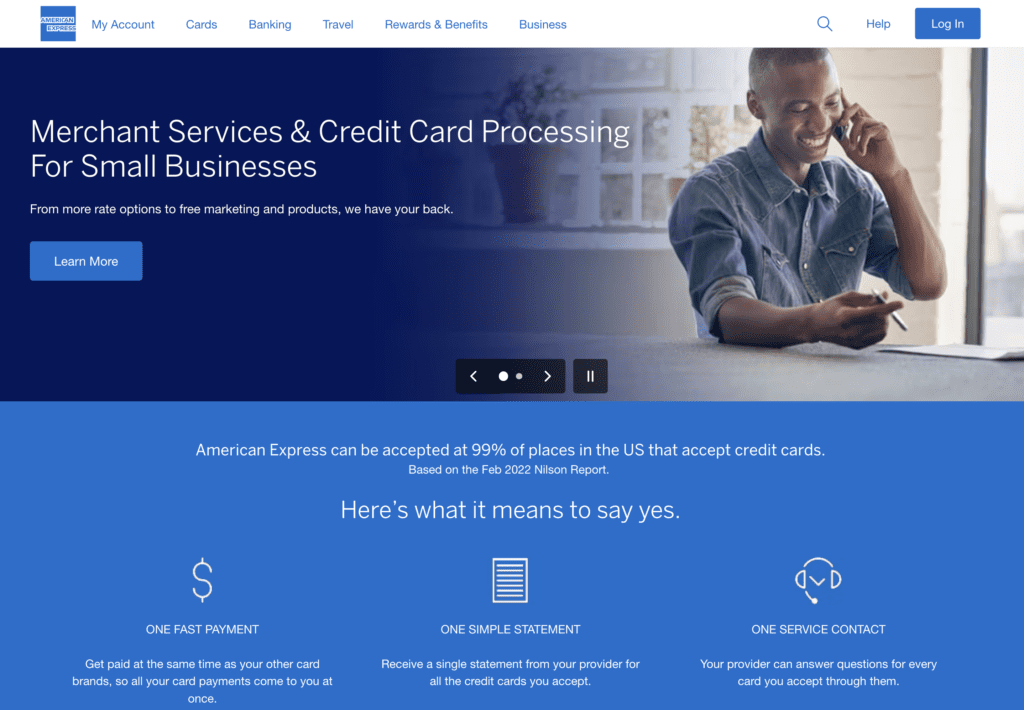American Express Direct vs. OptBlue
When it comes to the credit card processing world American Express tends to be their own monster. Amex has long been viewed as the outsider of the large four card brands when it comes to acceptance.
Higher rates have been the primary reason that a lot of merchants are hesitant to accept Amex. When you compare the average credit card processing fees between American Express and other cards like Visa and Mastercard, you’ll quickly see that Amex interchange rates are higher.
Recently, Amex has been making a push to boost spending on its network. There have been some new rate cuts through a program for certain merchants call Amex OptBlue.
What is Amex OptBlue?
Amex OptBlue is an alternative processing option released by American Express. Prior to the OptBlue program Amex cards were solely processed through a separate merchant account managed by Amex. This would result in higher, non-negotiable rates.
With the OptBlue pricing structure Amex opened up the processing of Amex through a separate merchant account. This is very similar to how a business accepts Visa, Mastercard and Discover.
Due to the fact merchants can now process Amex through a standard merchant service provider they can obtain lower rates than previously. Prior to this, Amex would only offer a flat rate non negotiable structure. Now, on the OptBlue pricing program merchants can negotiate with the processing company to decrease costs.
The Amex OptBlue program is designed specifically for smaller businesses.

To qualify for Amex OptBlue, your business must process less than $1 million in American Express sales per year. If you exceed this threshold, you’ll be required to enter an American Express direct agreement.
What is Amex Direct?
Amex Direct adheres a flat-rate structure that American Express implemented prior to the OptBlue program launch. Businesses that process more than $1 million Amex credit card sales per year are required to enter a direct agreement with American Express.
How is this possible?
American Express is a closed network. This means that they operate as card brand and its own issuing bank. Due to this structure, they handle additional roles compared to other card networks, which is why Amex has higher fees.
Believe it or not, these businesses on an Amex Direct agreement typically have to pay more than the businesses processing less than $1M a year in Amex transactions. This is the opposite of what you’d expect from businesses that process a higher volume, as most high-volume merchants are eligible for discounts through other processing methods.
But going directly to Amex Direct results in your business getting Amex’s standard rates, which tend to be much higher than the processors rates.
What’s the Difference Between Amex OptBlue vs. Amex Direct?
Amex OptBlue is set up through a merchant processor, whereas American Express Direct (or Amex ESA) is a direct processing agreement with American Express. Businesses processing less than $1 million in Amex sales per year can join the OptBlue program from the same processor that they’re using to accept other cards. But businesses processing more than $1 million in Amex sales must go directly to Amex for an agreement.
Here’s another look at the key differences between Amex OptBlue and Amex Direct/Amex ESA:
- Processing Costs: Amex OptBlue rates are typically cheaper than Amex Direct processing fees.
- Monthly Statements: OptBlue transactions will be listed on the same monthly statement provided by your processor, but Amex Direct is a separate bill.
- Reconciliation: It’s easier to reconcile Amex OptBlue deposits because everything is handled from a single provider.
- Payment Schedule: Your Amex Direct deposits may not align with your Visa, Mastercard, and Discover deposits. But if you’re part of the OptBlue program, everything will be deposited at the same time.
- Support: If you have questions or problems with Amex acceptance, you’d go to your processor for help if you’re on OptBlue. Direct merchants would need to contact American Express for support.
Overall, American Express OptBlue is more appealing for most merchants. But it’s a catch-22, because it’s obviously good news if you’re processing more than $1 million in Amex cards per year.

How Can I Negotiate Amex OptBlue?
Negotiating OptBlue pricing is actually very similar to negotiating pricing for the other card brands. The biggest thing is to first ensure you have secured an interchange plus pricing for all cards. If one processing company insists they can only offer a tiered pricing structure for Amex than we suggest to go elsewhere. This would be similar if not higher than going to Amex Direct.
Once the interchange plus pricing for all cards has been secured it is important to get the same markup for all four cards brands. To give you an example, if a processing company offers an interchange plus pricing of 0.30% + $.10 per transaction it should be that for all four card brands.
A lot of processing companies will offer a much higher markup for Amex transactions which is just another profitable category for them.
Negotiating your rates is one of the best ways to lower your American Express merchant fees. But it’s tough to do this on your own.
You can reach out to our team here at Merchant Cost Consulting for a free audit and analysis. We’ll let you know how much money you can save on Amex transactions, and credit card processing as a whole. Then we’ll negotiate your rates on behalf of your business, with no risk to you.
Additional Reading: American Express Chargeback Codes Explained
Final Thoughts on Amex Direct vs. Amex OptBlue
Merchant’s don’t have control over selecting Amex OptBlue or Amex Direct for card acceptance. The program you’re on and agreement is dictated by your sales.
If you’re processing less than $1 million in Amex card sales in a year, you’re eligible for Amex OptBlue. Any business that processes over $1 million in American Express card sales in a year must have a direct agreement with Amex.
While Amex OptBlue is generally better for merchants, it’s still great news if you’re on an Amex Direct contract. This means you’re getting more than $1 million from just a single card brand.
Regardless of which category you’re in, you should get an audit on your statements to see if you qualify for lower rates. Contact our team here at Merchant Const Consulting for help.


0 Comments